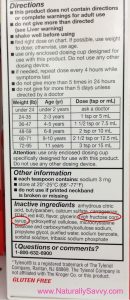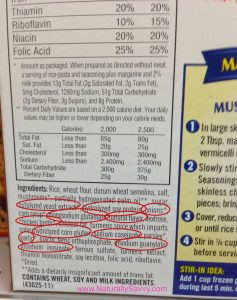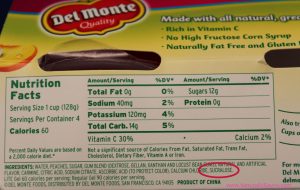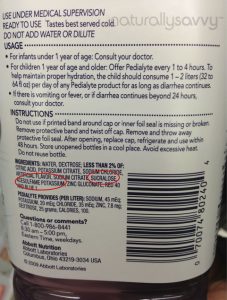- Finding Unshakable Power in a World That Wants to Pull Us ApartPosted 5 months ago
- What could a Donald Trump presidency mean for abortion rights?Posted 5 months ago
- Financial Empowerment: The Game-Changer for Women in Relationships and BeyondPosted 7 months ago
- Mental Health and Wellbeing Tips During and After PregnancyPosted 7 months ago
- Fall Renewal: Step outside your Comfort Zone & Experience Vibrant ChangePosted 7 months ago
- Women Entrepreneurs Need Support SystemsPosted 7 months ago
7 Scary Food Additives to Avoid
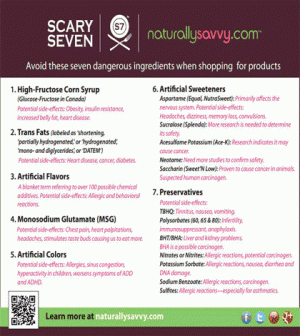
By Andrea Donsky | NaturallySavvy
I’m an avid label reader. In fact, I was given the nickname “Inspector Label” many years ago because of my passion for calling out harmful ingredients lurking in our foods (and because it would take me three hours to walk through a grocery store because I had to read every label on every single product I was interested in buying!). In fact, that’s what prompted me to write our book, Unjunk Your Junk Food, Healthy Alternatives to Conventional Snacks.
As consumers, we want to believe that food manufacturers have our best interest at heart, but the truth is, as we learn more about the foods in the grocery store, we realize these companies are more concerned with taste and shelf life than with our overall health.
Thousands of chemicals are used to make our food taste better, look better, and last longer, but most of these food additives, preservatives, and colorings are synthetic. Even the term “natural food” – once used to describe whole fruits and vegetables and unrefined grains – has now been expanded to include packaged, processed foods, many of which contain a wide array of chemicals.
According to a survey we conducted of over 2,600 consumers, 95% said they always read a food label, but 55% admitted they don’t recognize half the ingredients on the label! This is because packaged food is loaded with additives, many of which have chemical or scientific names. Although the amount of additives in our food is getting a bit out of hand (there are more than 6,000 food additives approved for use in the food industry), using ingredients to improve or enhance food has been the norm for centuries. Our ancestors used salts to preserve meat and sugar to preserve fruit. Spices and herbs were used for flavoring, and vegetables were fermented or pickled so they could be eaten during colder seasons.
Read more about the ingredients in conventional spices
Over the course of the two years it took my my co-author, Lisa Tsakos, and me to write our first book, Unjunk Your Junk Food (Gallery, 2011), we thoroughly researched ingredients commonly found in packaged foods across North America and grouped those that caused the most harm to our health into seven categories. We called them The Scary Seven™. They are:
Note: GMOs are not included on this list because companies don’t have to disclose them on their labels. However, they are on our “Also Beware Of” list, so please avoid them whenever possible. You can find a list of the “8 Most Genetically Modified Foods” here. You can learn more about the harmful effects of GMOs here.
1. High-Fructose Corn Syrup (HFCS)
HFCS is an inexpensive substitute for real sugar and is used primarily to sweeten beverages, including soft drinks. The American Heart Association identifies sugar-sweetened beverages as the main source of added sugars in our diet, suggesting that liquid calories are more likely to lead to weight gain than calories obtained from solid foods. HFCS, made from yellow dent corn, has been shown to promote increased belly fat and insulin resistance—not to mention the long list of chronic diseases that result directly. The fructose in high-fructose corn syrup goes directly to the liver, where it converts to fat and can ultimately lead to heart disease.
New research shows that fructose (like the fructose in HFCS) causes cancer cells to metastasize in a way that other sugars don’t, proving that there is a difference between fructose and other sugars. All sugars can lead to health problems, but high-fructose corn syrup is worse in terms of cancer risk.
In 2006, the U.S. government gave the corn industry $4,920,813,719 in subsidies, allowing them to sell their crops very cheaply and still make a profit. It’s no wonder food manufacturers prefer to use this sweetener over real sugar.
Side effects include:
– Heart disease
– Insulin Resistance (the step before type 2 diabetes)
– Increased belly fat
– Obesity
Here is how you can spot high-fructose corn syrup on a food label:
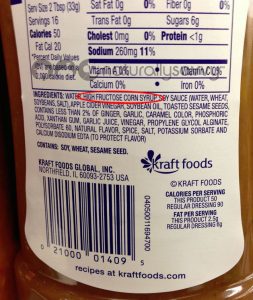
[pictured left: Kraft Asian Toasted Sesame Lite Anything Dressing]
Warning: High-fructose corn syrup is not only limited to food. It can also be found in medication such as the one below so always read the ingredients carefully:
[Pictured left: Kroger Children’s Pain Relief Acetaminophen Oral Suspension Pain Reliever]
View our Infographic on High Fructose Corn Syrup
2. Trans Fats
Vegetable oils are hydrogenated to transform them from a liquid to a solid fat, which is done to create a desired consistency and to increase the shelf life of foods. Trans fats raise your triglyceride and low density lipoprotein (LDL, the bad cholesterol) levels, which not only increases your risk of heart attack, but has been linked to prostate cancer, breast cancer, Alzheimer’s disease, diabetes and obesity.
Most experts agree there is no safe limit of ingestion. It is estimated that trans fats cause at least 30,000 deaths each year.
Read about the FDA’s proposal to ban artificial trans fats
Even if you already check labels for “trans fats,” you could be ingesting small amounts in your foods because the FDA allows food manufacturers to state “0 trans fat” on labels as long as the food contains less than 0.5 grams trans fat per serving (in Canada, that number is less than 0.2 grams per serving).
Read ingredient lists carefully and if you see any of the following terms on the label, put the product back on the shelf because they contain trans fats:
– Partially hydrogenated oils
– Hydrogenated oils (Note: If a product states “Fully hydrogenated oil” then it is not a trans fat).
– Shortening
– DATEM
– Mono and di-glycerides
Below is an example of a product that contains trans fats:
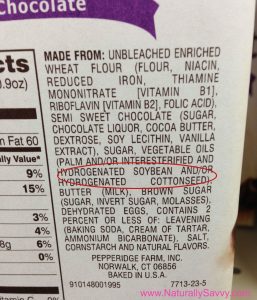 [Pictured left: pepperidge Farm Nantuket Dark Chocolate Chocolate Chunk Crispy Cookies]
[Pictured left: pepperidge Farm Nantuket Dark Chocolate Chocolate Chunk Crispy Cookies]
View our Infographic on Trans Fats
3. Artificial Flavors
Artificial flavors are additives designed to mimic the taste of natural ingredients. They are used to make processed food taste good because processing removes much of the flavor.
When you see “artificial flavors” on a food label, it could mean a single unnatural additive or a blend of hundreds of chemicals. Strawberry flavor, for example, contains 49 man-made chemical ingredients and the typical artificial butter flavor is made of 100 different man-made chemicals! They are typically found in processed and refined foods, and are known to cause allergic and behavioral reactions. Unfortunately the FDA does not require flavor companies to disclose ingredients as long as all the ingredients have been deemed “Generally Recognized as Safe (GRAS).” This protects the proprietary formulas of the companies that produce artificial flavors, but it allows for many chemicals to be hidden under the word flavor on the ingredients list.
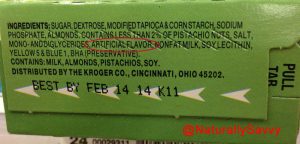
[Pictured left: Instant Pudding & Pie Filling Pistachio]
View our Infographic on Artificial Flavors
4. Monosodium Glutamate (MSG)
Monosodium glutamate, or MSG, is an artificial flavor found in thousands of processed foods, from fast food, to chips, to soup. While the FDA has classified MSG as “generally recognized as safe,” there have been numerous consumer complaints related to adverse reactions to foods containing MSG, including swelling, facial numbness, heart palpitations, nausea and weakness.
Read our Hidden Scary Sushi Ingredients Exposé
Glutamate, an amino acid, occurs naturally in many foods, but it’s also a component of MSG. The problem arises when flavor-enhancing compounds called free glutamates are added to foods. They act as excitatory neurotransmitters, causing the nerves in the brain to fire rapidly and repeatedly. While this stimulation heightens our sense of taste, it can also cause a variety of symptoms, including impaired memory, perception, cognition, and motor skills.
MSG can be hidden on a food label under many different names including: Yeast extract, autolyzed yeast extract, hydrolyzed vegetable protein, vegetable powder, and many more. For a more comprehensive list, please click here.
[Pictured left: Rice A Roni Chicken & Mushroom Flavor]
5. Artificial Colors
The use of artificial colors has increased 50 percent since the 1990’s, and the bright hues are found in everything from cereals to cosmetics, candy to pharmaceutical drugs. According to the Center for Science in the Public Interest, chemical food dyes are made from known carcinogens.
Artificial colors make foods look pretty, but they’re deceptive. Pediatricians and parents have long complained about artificial dyes as they have been linked to hyperactivity, attention deficit disorder (ADD) and attention deficit/hyperactivity disorder (ADHD). Artificial dyes can even affect the behavior of children who don’t have behavioral disorders.
As a mom to three, artificial dyes are my nemesis! They are found everywhere–at birthday parties, friend’s houses, school, and pretty much anywhere kids are found. In our house, I can tell within ten minutes if one of our kids has ingested artificial dyes because of how they negatively affect their behavior. We call it “The Crazies”.
My ten-year-old son said it best: “When I eat food coloring I get crazy and don’t even know myself.”
In the U.S. the type of artificial dye must be listed on the label (i.e. red #40, blue #1, yellow #5). However if you live in Canada, food manufacturers are not required to list the type of food coloring used in their products. On a food label, you will simply see them listed as “colour.” Buyer beware!
Read more about natural food coloring
Below is an example of how you would see artificial dyes written on a label:
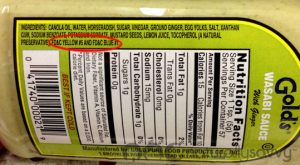 [Pictured left: Gold’s Wasabi Sauce with Ginger]
[Pictured left: Gold’s Wasabi Sauce with Ginger]
View our Infographic on Artificial Colors
6. Artificial Sweeteners
Many of us use artificial sweeteners in place of sugar to lower our caloric intake. However, while it is recommended that sugar be avoided, replacing that sugar with artificial sweeteners is just as bad for you.
Acesulfame potassium (also known as ace-K and sold under the brand names Sunett and Sweet One) is a calorie-free sweetener, and while early studies indicated it may cause cancer in animals, little research has been done since it was approved in 1988. Aspartame, the sweetener in Equal and NutraSweet, is found in more than 5,000 products. The body converts aspartame to formaldehyde, a carcinogen that’s used in embalming and to treat lumber.
Aspartame has been linked to numerous adverse effects, including headaches, dizziness, mood changes, convulsions and memory loss, and the FDA has received more complaints related to aspartame than any other food additive. I interviewed a woman who went temporarily blind from ingesting too much aspartame. You can read my interview here.
Neotame is chemically similar to aspartame, but there have been no long-term studies to ensure its safety.
Saccharin, in Sweet’N Low, was the first commercial artificial sweetener, and it’s been shown to cause cancer in animals.
Finally, Sucralose, sold under the name Splenda, is 600 times sweeter than sugar, and a new study shows it may cause leukemia in mice.
[Pictured left: Del Monte Lite Peaches in Strawberry-Banana Flavored Gel Fruit Cups]
I recently took my two-year-old daughter to the doctor because she had a persistent rash. The pediatrician told me that he was pretty sure it was an allergic reaction to something she ate, and I should go to the pharmacy and buy a bottle of Benadryl to get rid of the rash.
My homeopath was unreachable, so I went to the pharmacy and looked at the options on the shelf. Each and every single one of the allergy medications contained at least one or two of The Scary Seven™ ingredients including artificial colors and artificial sweeteners (in many cases there was more than one type). I asked the pharmacist if she could help me find a homeopathic alternative specific to her symptoms (I prefer using homeopathic remedies for my children as a first line of defence as they respond very well to them) and went on to ask her why companies include artificial sweeteners in children’s medications. She told me it was because parents complained there was too much sugar in children’s medicine so they replaced it with chemical sweeteners like sucralose and acesulfame potassium. In my opinion, substituting one harmful ingredient for another is not the answer and I’d rather avoid is entirely, especially when there are alternative remedies, like homeopathics, available.
So, I bought the homeopathic alternative Sabadil from Boiron, and within two hours her rash was gone!
Below is an example of how two types of artificial sweeteners are used in a popular product given to kids when they are sick and/or dehydrated. In addition to the artificial sweeteners sucralose and acesulfame potassium, it also has artificial flavor, and the artificial colors red 40 and blue 1–both of which are on our Scary Seven™ list of ingredients.
View our Infographic on Artificial Sweeteners
7. Preservatives
Prepared foods are packed with preservatives to prolong their shelf life (they prevent oxidation and slow rancidity). But these chemicals can have a detrimental effect our health, and many are allergens and/or possible carcinogens.
The preservatives found to cause the most harm include:
BHA (butylated hydroxyanisole) and BHT (butylated hydroxytoluene): Known to affect kidney and liver function, and a possible carcinogen.
Polysorbate 60, 65 and 80: Shown to affect the immune system and have caused severe anaphylactic shock–a potentially lethal allergic reaction. Several studies have also linked polysorbate 80 to infertility.
Sodium benzoate: Linked to allergic reactions and is a carcinogen.
Sulfites: Used in dried fruit, wine, flavored vinegars, sausages and other foods. Sulfites are common allergens and have been linked to headaches, bowel irritability, behavioral problems and rashes. Asthmatics need to be particularly careful about sulfites as they can cause sudden constriction of the airways.
TBHQ (tertiary butylhyroquinone): A petroleum-based food additive, TBHQ has been associated with nausea, vomiting and tinnitus, and has been linked to cancer.
Potassium Sorbate: Linked to DNA damage.
Nitrates: Used to cure meats. When combined with stomach acids, nitrates produce nitrosamines, which have been linked to cancer.
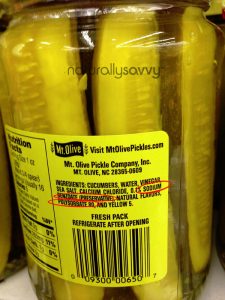
[Pictured left: Mt. Olive Kosher Dill Spears Made with Sea Salt]
View our Infographic on Preservatives
The good news is there are healthier options for our favorite foods that don’t contain harmful chemical additives. Our passion at Naturally Savvy is finding these alternatives, vetting them, and then sharing them with you. You can find many of our recommended alternatives in our free e-books, Label Lessons: Your Guide to a Healthy Shopping Cart and Label Lessons: Unjunk Your Kid’s Lunch Box, and in our book, Unjunk Your Junk Food: Natural Alternatives to Conventional Snack Foods.
You don’t have to give up the foods you love, just give up the toxic chemicals. As we like to say: “Take the junk out of your junk food.”
So the next time you are at the grocery store deciding which products to buy, turn the package over and instead of looking at the Nutrition Facts Panel, read the ingredients first. Because if a product contains any of The Scary Seven™ ingredients, it doesn’t matter how many calories or how much fat it has, you shouldn’t be eating it anyways.
My goal is to empower you to become your own Inspector Label.
Image credits: Andrea Donsky


